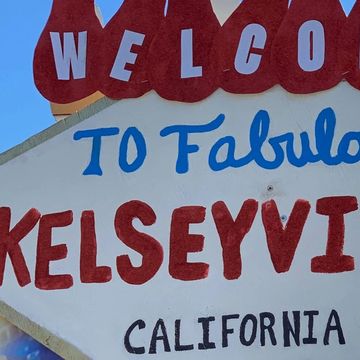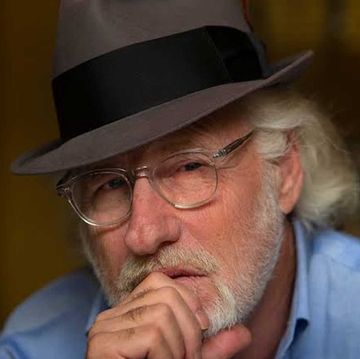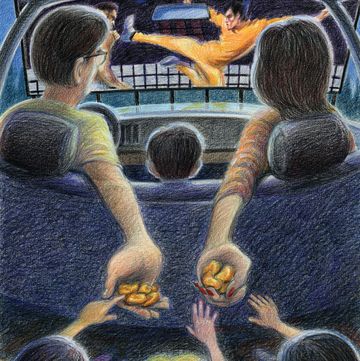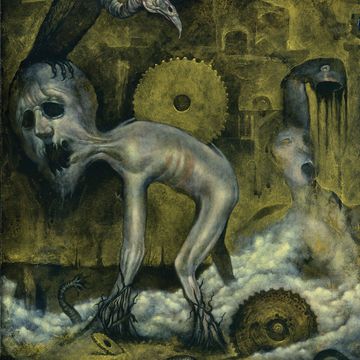In 1940, John Steinbeck was in a bad place. He’d finished the 1930s with the publication of The Grapes of Wrath, his greatest novel, after a string of critical and popular successes including Of Mice and Men, The Red Pony, and Tortilla Flat. Steinbeck was now famous, and he hated it. The strangers showing up at his ranch near Los Gatos unnerved him, and the calls and letters overwhelmed him. He detested being recognized and never wanted his picture taken. Even a positive side of celebrity like winning awards was a problem, because Steinbeck dreaded public appearances—a dilemma for a man who would go on to win a Nobel Prize in Literature.
While fame pressed in, Steinbeck was increasingly disliked in his hometown of Monterey, where he also had a house and where residents viewed him as a traitor and political radical for supporting workers’ rights and speaking up for migrants. The Associated Farmers of California launched a smear campaign against him, and rumors abounded. Locals refused to do business with him. He grew so paranoid, he walked around “with steel bolts in his pockets, ready to press them into his fists if he got in a fight,” according to his biographer William Souder. On top of that, Steinbeck’s decade-long marriage was crumbling, and U.S. involvement in World War II was looming. He needed an escape. The solution, he concluded, was to sail to Mexico with his best friend on a scientific expedition. He would bring his wife, Carol, too.
His partner in this was Ed Ricketts, marine biologist, pioneering ecologist, and Steinbeck’s muse. In 1939, the same month The Grapes of Wrath had come out, Ricketts had published Between Pacific Tides, his groundbreaking guidebook to the intertidal zone of the Monterey Peninsula. The two decided to coauthor a book on the tide pools of Baja, Mexico. In March 1940, they boarded the ship Western Flyer and embarked on a 4,000-mile voyage to the Sea of Cortez (or Gulf of California). There, they collected thousands of specimens, including 50 new species, some of which are currently owned by the Smithsonian.
The six-week trip had a reach far beyond what Steinbeck and Ricketts could have imagined. After the voyage, Western Flyer was used hard as a fishing boat, went missing for years, and became so neglected, it sank, twice. Against the odds, it has been restored and is returning to Monterey as a vessel of scientific education. Likewise, the initial version of The Log from the Sea of Cortez, coauthored with Ricketts, was ignored when it came out. The original travelogue, which combined marine biology with stories of Mexican adventures, was published as Sea of Cortez right before the bombing of Pearl Harbor on December 7, 1941, and forgotten as the country went to war. Ten years later, Steinbeck extracted his travel narrative, added the essay “About Ed Ricketts,” and published the book as The Log from the Sea of Cortez under his name. Today, it’s considered a classic for its humor and prescient environmental observations. This book’s slow burn is a testament to Steinbeck’s legacy and Ricketts’s originality, but also a record of change. For after Steinbeck returned from the Sea of Cortez, his life was never the same again.
When tracing Steinbeck’s journey to Mexico, it makes sense to start at the beginning, at Ricketts’s lab in Monterey. In 1923, Ricketts opened Pacific Biological Laboratories, where he sold prepared microscope slides and preserved specimens to institutions. If you wanted an animal to dissect in a science class, Ricketts was the person to see. Today, located in the middle of the tourist shops and chain restaurants of Cannery Row, the lab is a weather-beaten two-story rectangle jammed between former canneries. Five windows form a strip in the front of the building, and a wooden staircase leads up to the door.
This article appears in Issue 26 of Alta Journal.
SUBSCRIBE
Jordan Leininger, artifacts specialist for the City of Monterey, answers my knock. Inside, the lab is rustic and cabin-like, with thrift store furniture and unpainted wood paneling. Jazz posters and paintings cover the walls. After Ricketts’s death, a gentlemen’s club met in the building to carry on his brand of bohemian intellectualism. The Monterey Jazz Festival was conceived here. Hank Ketcham, creator of the comic strip Dennis the Menace, was a club member. When Louis Armstrong visited, he performed in this room.
The building is actually the second one to stand on this spot. In 1936, the neighboring cannery caught fire owing to negligence by PG&E. Ricketts had to flee for his life. “He lost everything,” says Leininger, and Ricketts never received a full settlement from the fire. “He owned the lot next door, so he sold it and built this in 1937. It’s just a Depression-era two-story shack, but it has held up very nice for almost a hundred years.”
Ricketts was a philosophical person who seemed to do exactly what he wanted in any situation. Short and handsome, with a reddish-brown beard, he was a womanizer who carried on many complicated love affairs in the back room of the lab. He read widely and deeply and could talk about everything from Chinese literature to Jungian psychology to the poetry of Robinson Jeffers, who lived nearby. He loved music, including Gregorian chants that he played on a phonograph so they drifted out to the workers of Cannery Row. The parties at his lab could go on for days among the cages of rattlesnakes and aquariums of sea anemones. He was a heavy drinker. According to Steinbeck’s second wife, Gwyn Conger, every morning Ricketts went down the street to Wing Chong Market for “six cans of beer, a large hunk of cheese, and a pineapple pie. Some breakfast.”
Steinbeck was so inspired by Ricketts, he fictionalized him in Cannery Row, Sweet Thursday, In Dubious Battle, The Grapes of Wrath, and The Moon Is Down, to name a few. But he wasn’t the only one who enjoyed his friend’s stimulating company. In fact, Ricketts was the center of an artistic salon that included author Henry Miller and musician John Cage. The mythologist Joseph Campbell was also part of the group until he flirted too much with Carol Steinbeck.
“Campbell and Carol started getting really friendly,” Leininger says. “Supposedly, Steinbeck pulled a gun on Campbell and asked him, ‘Is it physical or psychological?’ and Campbell said, ‘It’s psychological.’ Steinbeck told him to get out and don’t come back, and that’s when Campbell and Ricketts went to Sitka, Alaska, on a collecting trip.”
Behind the lab, beyond the holding tanks Ricketts used for specimens, the cement yard looks out on Monterey Bay. Leininger leads me to the lower garage, where scientific business was conducted. On one side are a counter and shelves stocked with original supplies and jars of specimens. The other half of the room contains Baby Flyer, a wooden dinghy Ricketts took to the Sea of Cortez. Behind that lies a fireproof safe he used to store cheese.
Ricketts, who never completed his degree at the University of Chicago, was marginalized by his contemporaries for a lack of education, but he was a serious biologist. Between Pacific Tides was revolutionary for how he grouped species. At a time when scientists organized solely by taxonomy, he took a holistic approach, breaking the tidal region into zones and studying how the creatures cooperated within their habitats. His theories were influential in developing the field of ecology. Rachel Carson later used Ricketts’s book as the basis for The Edge of the Sea, her guide to the Atlantic shoreline. Steinbeck was also influenced by Ricketts’s theories and tried to apply them to people, to varying success. In his biography Mad at the World, Souder writes, “Steinbeck eventually came to believe that you could not understand humankind by looking at individuals.… The answers were all in the phalanx, the superorganism, the group unit.”
After I leave the lab, I visit the Great Tide Pool in nearby Pacific Grove, where Ricketts collected specimens. When the tide is out, the watery crevices in the rocks are full of marine creatures. If I ignore the mansions and golf course behind me, I can imagine the place as it was when Ricketts was here. The ocean is largely the same, although warming waters from climate change are causing new species to migrate into the area. But the sardine population, which collapsed in 1946, is rebounding thanks in part to conservation efforts. On this point, Ricketts was again ahead of his time. He repeatedly warned the industry that the sardines were being fished out. In 1947, when people were asking what had happened, he wrote in the Monterey Peninsula Herald, “The answer to the question ‘Where are the sardines?’ becomes quite obvious.… They’re in the cans!”
In the tide pools, I mostly see hermit crabs. Hundreds of them, wearing sea snail shells, crowd around strips of kelp like a family at a Thanksgiving table. There’s almost as much drama as during the average Thanksgiving as the crabs jostle for position. It’s engrossing to watch this miniature world, and I can understand why it appealed to Steinbeck to escape his troubles and spend time doing just that.
Look for the crow’s nest,” Captain Paul Tate had said. As I pull into the marina in Newport, Oregon, I scan the masts of the ships. Western Flyer is temporarily moored here on its journey from Port Townsend, Washington, to its new life in Monterey. Since most modern ships no longer use crow’s nests, only older vessels have them. Sure enough, there is the bucket-like lookout suspended against the backdrop of the looping Yaquina Bay Bridge. Western Flyer is docked in the corner by the road.
It is a lovely ship. Built in 1937 out of old-growth Douglas fir, it’s a 77-foot purse seiner, a type of boat used for sardine fishing. It’s white with seafoam-green accents. Between the high, straight bow and the deckhouse studded with round windows, it has at once the sleek charm of a vintage sports car and the friendliness of an old Disney cartoon. It looks like something Donald Duck would sail.
The wind lashes me as I hurry down the pier. Tate, a dignified man with silver hair and blue eyes set off by his sweater and denim baseball cap, ushers me inside the ship’s cabin to escape the stormy weather. The galley smells of wood cleaner and gleams like a fine piece of furniture. Much of the original wood has been rehabilitated, including parts of the seats, ceiling, window frames, and floors. A pristine vintage stove, found in a store basement in Portland, Oregon, sits by a counter with a sink. Across from it, a table stands next to built-in benches. I can picture Steinbeck and Ricketts sitting there, drinking ubiquitous beers and milking the crew for stories.
It’s amazing the ship still exists. After the voyage to Mexico, Western Flyer was “ridden hard,” as Tate puts it. For decades, it was used to catch sole, salmon, cod, and crab in Alaska, British Columbia, and the Pacific Northwest. At one point in the 1970s, it was renamed Gemini and disappeared for a few years. By 2011, it had fallen into disrepair in Washington. The Cannery Row Foundation attempted to buy the ship, but when finances didn’t work out, it was snapped up by a real estate developer who hoped to use it in a hotel he was planning for Salinas, Steinbeck’s birthplace. He wanted the ship to float in a moat near the hotel café, but it never happened. Finally, in 2012, a board in the hull broke, and the boat sank near Anacortes, Washington. It returned to the surface two weeks later, only to sink again in January 2013. This time, it was submerged for six months.
When it was raised, Western Flyer was a brittle wreck caked with barnacles and mud. Marine geologist John Gregg, a fan of Ricketts and Steinbeck, took on the task of fixing the ship. After eight years and millions of dollars, it has been painstakingly restored, and it’s returning to Monterey, where it will become a research facility and floating classroom. The fishhold where Steinbeck and Ricketts prepared specimens will be filled with state-of-the-art equipment, including an ROV—remotely operated underwater vehicle—for deep-sea exploration.
As quaint as it is, there was nothing special about Western Flyer when Steinbeck chartered it for the voyage with Ricketts. In fact, he didn’t have much choice in the matter. The captain, Tony Berry, was the only one in Monterey willing to let the ostracized Steinbeck use his boat. Other crew members mentioned in The Log from the Sea of Cortez include engineer Travis “Tex” Hall and seamen Horace “Sparky” Enea and Ratzi “Tiny” Colletto.
If Ricketts was Steinbeck’s muse, Carol was his editor. She typed his manuscripts, reworked his language, and gave him key creative ideas. The Grapes of Wrath was “their shared creation,” writes Susan Shillinglaw in the biography Carol and John Steinbeck. “Together [they] had produced the manuscript—he writing, she typing and editing and coming up with the title.” But months later, as Steinbeck was reaping the benefits of their work, he had an affair with Conger. The trip to Mexico was supposed to rekindle his marriage to Carol, but during the voyage, their interactions seemed cold, if polite. Carol slept in the wheelhouse, and Steinbeck bunked with the crew. When she bathed topless, he was the only one who didn’t look at her. Oddly, she later said the trip was the happiest time of her life. In The Log from the Sea of Cortez, Steinbeck doesn’t mention her at all.
The Sea of Cortez is sometimes called the Aquarium of the World. It’s remarkably biodiverse, home to nearly 900 species of fish and over 30 types of marine mammals, including the planet’s largest animal, the blue whale.
Western Flyer left Monterey on March 11, 1940, and made a leisurely weeklong trip to Cabo San Lucas, on the tip of the peninsula, with one stop in San Diego to refuel. Then the travelers looped the Sea of Cortez, making 25 stops over a three-week period. They used Baby Flyer to get to shore, struggling with an unreliable outboard motor called the Hansen Sea-Cow, which, Steinbeck wrote, was “not only a living thing but a mean, irritable, contemptible, vengeful, mischievous, hateful living thing.… It loved no one, trusted no one, it had no friends.” At each tide pool, they braved stinging worms and spiked urchins to gather as many creatures as possible. They were amazed by what they saw. The coastline, Steinbeck said, was “ferocious with life.”
From what I can tell, southern Baja doesn’t photograph well. Based on pictures, I was expecting brown hills covered with clumps of bushes like lint balls on a sweater. But as I head toward Cabo San Lucas on a fine September day, I’m pleasantly surprised by the vibrant countryside. Lime-green butterflies hurl themselves through the air, and herds of goats wander in and out of the greenery. Native plants grow beside the road in a lush tangle, and elephant cacti stick up from the surrounding vegetation like deformed glove mannequins. In the distance, the orange sand cliffs give way to mountains.
When I come to the outskirts of Cabo San Lucas, I notice what at first remind me of the homeless camps under the bridges and along the highways of California. But these are more permanent structures, made from boards or bricks, some with tarps or plywood for roofs. Laundry hangs in fenced yards, and gardens grow among discarded tires. This evidence of poverty slowly lessens as I head through the back of town toward the tourist section. Shacks give way to neighborhoods, which then turn into commercial strips. These grow larger as I approach the shoreline, until they’re replaced by cavernous restaurants and resorts perched on the water.
Although Cabo San Lucas now caters to wealthy tourists, Steinbeck describes it as “a sad little town” where flooding has recently wiped out homes and infrastructure. The cantina they visit is full of “morose young men” who are “waiting for something to happen.” The Log from the Sea of Cortez is full of such encounters with the locals. The passengers and crew of Western Flyer spend Good Friday in church, where a choir of children charms them with Spanish madrigals. On a beach, they pay little boys to collect specimens, often with humorous results. Ranchers invite them to go sheep hunting, and Steinbeck is pleased when they pass the time eating and drinking instead of killing animals. At another point, he hears the story that inspires his novel The Pearl.
While the descriptions of people are often warm and funny, they can read as dated and stereotypical by current standards. The book holds up better when describing marine life. The animals are like minor characters, from the shark on the boat that refuses to die to the puffer fish a child uses to poison a cat to the Sally Lightfoots, colorful crabs that are difficult to catch and delightful to watch. When I arrive at my hotel, I spot a large red crab out the window and wonder if it’s a Sally Lightfoot. It moves so nimbly over a rock, it could be ice-skating.
Almost every time I look into the water, I see animals. Gumball-size sea snails stick to boulders, puffer fish drift through the marina, minnows nibble algae, and a silver school twirling near a boat is suddenly divided by a hungry sea lion. Still, the shore isn’t quite “ferocious” with creatures. In fact, when I go kayaking off Playa Pichilingue, near where Steinbeck, Ricketts, and the others collected samples, I find myself wondering where the life is hiding. Two porpoises lope in the distance, but that’s about it.
The water is exquisite as it laps onto the white-sand beach. When ruffled by the wind, it looks like beveled glass. As I paddle farther out, ghostly patches seem to ripple below my kayak. Later I learn they’re bleached coral, a sign of a struggling reef. While Baja has comparatively healthy coral reefs, warming weather is causing bleaching in shallow water.
One of the most forward-thinking chapters of The Log from the Sea of Cortez involves a fleet of 12 Japanese shrimping ships that are dredging the sea. They are not only “taking every shrimp from the bottom, but every other living thing as well…literally scraping the bottom clean.” Steinbeck, aware of the waning canning industry in Monterey, warns Mexico not to allow its resources to be destroyed like “our timber, our land, our fishes.… [The United States] should be taken as a horrible example.” With unusual foresight for the time, he describes the dredging as “a true crime against nature and…the eventual welfare of the whole human species.”
Years after he wrote those words, industrial fishing of sardines, tuna, and shrimp took a toll. “Some shark species, such as the great hammerhead, are already locally extinct,” says Frida Lara, a scientist at Orgcas, a women’s nonprofit dedicated to conserving Baja’s marine life. “Others, like the scalloped hammerhead sharks, used to form schools of up to 200 sharks. Dr. Sylvia Earle once mentioned that ‘the hammerheads were like stars in the sky.’ Nowadays, it is very rare to see 20.”
The good news is that marine protection can help areas recover. Cabo Pulmo, which Western Flyer visited, has been a marine reserve for 28 years; fishing was initially restricted and is now banned inside the national park. In that time, according to Lara, the biomass has recovered by 400 percent. Elsewhere, fishing bans, marine protections, and other changes have returned missing animals to the region. Giant mantas, which were absent, are starting to appear again. “It is not rare to see orcas, sperm whales, schools of mobulas,” says Lara. “These successes show us that if we protect the oceans in the Gulf of California…the biodiversity has the capacity to recover.”
On my last day in Baja, I hop a boat to see the Friars, giant sandstone rocks that stand like sentinels where the Pacific Ocean meets the Sea of Cortez. The day before, there was a sudden, intense storm, like a violet carpet rolling across the sea. That afternoon, I watched enormous waves pummel the waterfront, but now it’s a beautiful day. Sunlight makes the formations seem almost golden. The rocks, carved by churning water, have names like the Arch and Pirate’s Cave, which give them a sense of intrigue. Nearby, sea lions tussle over who will sit on the highest part of a rock. Pelicans float next to snorkelers. Fish swarm to the surface whenever breadcrumbs are tossed into the waves. Here, at last, is some of the abundance described in the book.
The peace Steinbeck found on the trip must have broken as soon as Western Flyer returned home. When the boat docked in California, the travelers learned that Germany had invaded Norway. Problems could no longer be ignored. Steinbeck was still famous and locally disliked. He and Carol divorced in 1943, and his work was never the same. He married Conger and moved to New York.
But the biggest change was the accidental death of Ed Ricketts eight years later. In 1948, Ricketts was driving to buy food when his car got stuck on the railroad tracks in Monterey. He was struck and killed by the evening train. It was three days shy of his 51st birthday. When Ricketts went, “Steinbeck buried part of his own soul,” writes Shillinglaw. A tribute to his best friend was included in later editions of The Log from the Sea of Cortez. “Finally there is another reason to put Ed Ricketts down on paper,” Steinbeck wrote. “He will not die.”
As my boat heads toward shore, I imagine Cabo San Lucas as it would have been in 1940: no resorts, no developments, no T-shirt shops, no Señor Frog’s. (I count three of these chain restaurants on the marina alone.) Steinbeck bemoaned the tourism industry, writing that soon “the airplanes will bring week-enders from Los Angeles” and the towns “will bloom with a Floridian ugliness.” This seems prophetic until you consider that a major writer rhapsodizing about the area probably encouraged some of that tourism. Anyway, I can hardly complain, as I’m a tourist myself.
The Log from the Sea of Cortez reminds me of the interconnection between humans and the environment, but also of the ripple effect of history. A writer and a scientist take a trip to examine Mexican marine life, and almost a century later, people are reading their story, retracing their steps, and penning long articles about them. The journey to the Sea of Cortez didn’t change the things that made Steinbeck unhappy. War still came. His best friend died too young. And yet he couldn’t have predicted that the ship he chartered would be raised from the bottom of the sea and restored so that new people could learn about the ocean. The difficulty of being human is that we have so little control over change, even as we cause it every day. Sometimes things work out the way we want, sometimes they don’t, but it would be a mistake to assume that our actions don’t matter.
“All things are one thing and that one thing is all things—plankton, a shimmering phosphorescence on the sea and the spinning planets and an expanding universe, all bound together by the elastic string of time,” Steinbeck writes. “It is advisable to look from the tide pool to the stars and then back to the tide pool again.”•
Joy Lanzendorfer’s first novel, Right Back Where We Started From, was published in 2021. Her work has appeared in the New York Times, Washington Post, Raritan, the Atlantic, and Ploughshares as well as on NPR and for the Poetry Foundation, among others.






















